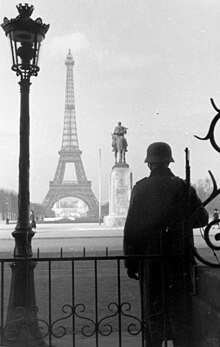Paris TV station
TV station Paris or "Paris-Télévision" was the name of German occupation television in occupied France from 1942 to 1944 .
history
When the German Wehrmacht invaded France in the summer of 1940 , the development of French television was still in the trial broadcast phase. The transmission system of the TV station Radio-PTT Vision , which was housed in the Eiffel Tower and had been in operation since May 24, 1937, was already the most powerful in the world with an output of 30 kW. When the transmitter, which was made inoperable shortly before the German invasion, fell into the hands of the occupiers in June 1940, they initially showed no interest in the booty. It was not until May 1941 that an order to dismantle the transmission systems for raw material procurement led to discussions about the repair and use of the transmission systems for television purposes. Kurt Hinzmann , former broadcasting director of the television station "Paul Nipkow" Berlin and assigned to Alfred Bofinger's "Rundfunk group" since July 22, 1941 , advocated the establishment of a television program to look after the German troops (hospital television). In addition, an additional sales market was to be created for the German electrical industry with the help of the German 441-line standard in France. From a military point of view, repairs to the transmitter systems also made sense, because they could also be used as jammers for enemy aircraft.
The competencies for the Paris television station were determined by order of the Wehrmacht High Command on May 20, 1942. After that, the station was under the command of the French military commander (MBF), Carl-Heinrich von Stülpnagel , with the MBF's propaganda department responsible for the program and the French Higher News Leader (HNF) for the technology. A radio task force (FET) subordinated to the NHF was responsible for the technical installation and monitoring of the transmission operation. The financing was partly taken over by the French Radiodiffusion Nationale (RDN) and the German Reich Ministry of Post . Kurt Hinzmann became director of the station.
Since the existing recording studio of Radiodiffusion Nationale was too small, a makeshift studio was set up in the former Czech embassy on Rue Charles-Floquet. From there, the first test broadcasts were carried out in early August 1942. When the station started its programming on May 7, 1943, the recording studios had meanwhile moved to the converted premises of the former “Magic City” dance palace in rue de l'Université 176/180.
A week before the liberation of Paris, the station stopped its programming. On October 1, 1944, French television took over the facilities. After the end of the war, France was the first country in Europe to be able to broadcast programs again from the former studio of the television station Paris, whose technical equipment the Germans had left undamaged.
audience
Based on the model of the Berlin TV station "Paul Nipkow", the program was primarily used to entertain the wounded German soldiers in Paris hospitals. In addition, it was intended to address the French population as pro-German propaganda; the program broadcast in German standard could also be received on French televisions with a somewhat poorer picture quality. Estimates of the number of receivers available vary widely (between a few hundred and around 1,000). However, the German occupation broadcaster is unlikely to have reached a large French audience.
program
From May 7, 1943 to August 16, 1944, the Paris television station produced and broadcast daily 3½ to 4-hour, later 5¼-hour video programs, which were supplemented by sound programs from the German broadcaster.
The program was bilingual and consisted mainly of undemanding entertainment. In addition to the regular contribution “From the contemporary events”, the company produced mainly troop support programs such as “Variété”, “Variété in front of the wounded”, “French play for Germans” and “Musicians and artists in gray rock entertain their comrades”. Sports programs and television games were also broadcast frequently. The in-house productions were supplemented by newsreels , cultural , short and feature films. Propaganda films were only occasionally included in the program.
Program on June 7, 1944 (one day after the Allies landed in Normandy):
- 10:00 - TV film broadcast: "Flea in the ear"
- 11:13 - "Rice and wood in the land of the Mikado"
- 11:27 - "Lore"
- 11:40 am - "The watch shop"
- 8:30 p.m. - Current affairs
- 20:45 - direct broadcast from the studio: "Venetian Wedding" (German)
- 21:05 - TV film broadcast: "Baroque City Dresden"
- 21:19 - "In 40 minutes"
- 21:31 - "The cradle of the forest"
- 21:42 - "Good evening, good night"
literature
- Ansbert Baumann: Between propaganda and information. The development of Franco-German cooperation in radio and television. In: Revue d'Allemagne 37 (2005), pp. 7-27.
- Michael Rother: Paris TV station. German-French occupation television (1942–1944). In: Wolfgang Drost u. a. (Ed.): Paris sous l'Occupation. Paris under German occupation . Lectures of the 3rd Colloquium of the Universities of Orléans and Siegen. Winter, Heidelberg 1995, ISBN 3-8253-0246-6 , pp. 156-165.
- Petra Truckendanner: The Paris TV station. German-French occupation television 1942–1944. In: Rundfunk und Geschichte 25 (1999), pp. 107–117.
Web links
- Petra Truckendanner: The Paris TV station. German-French occupation television (1942–1944). (DOC; 68 kB) Summary of the author's dissertation: The television station Paris. German-French occupation television 1942–1944. Salzburg 1998. (No longer available online.) In: www.medienrezeption.de. July 27, 1999, archived from the original on December 26, 2004 .
- Petra Truckendanner: Paris during the Nazi occupation: Nazi propaganda from the Eiffel Tower - SPIEGEL ONLINE. In: spiegel.de. 3rd December 2014 .
Individual evidence
- ↑ Detailed view of the film. RICE AND WOOD IN THE LAND OF MIKADO. In: murnau-stiftung.de. Retrieved May 16, 2019 .
